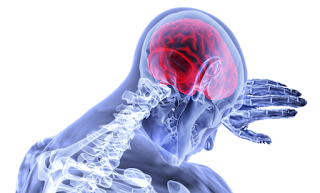Stroke or internal thrombosis - STROKE
 |
| Stroke or internal thrombosis - STROKE |
A medical emergency and a doctor
Fortunately, stroke can be treated. High cholesterol (high cholesterol), is the main cause, high cholesterol in the blood.
Stroke symptoms
Pay attention to the following early signs:
Difficulty walking: If a person has a stroke, they may stumble, feel dizzy, lose their balance or lose coordination (between the senses, movement and speech)
Speech difficulties: If a person has a stroke, his speech may become slurred or he may lose the ability to find appropriate words to describe what is happening to him and him (aphasia, or loss of language). Try to repeat a simple sentence. If you can't do that, then it is likely that you are having a stroke.
Paralysis or numbness on one side of the body: If a person has a stroke, they may lose sensation or feel paraplegic (paralysis on one side of the body). Try to raise both arms over your head at the same time. If one of them starts to fall, you are likely having a stroke.
Vision difficulties: If a person has a stroke, he may suffer from sudden blurring of vision, he may lose vision for a few moments, or he may suffer from diplopia (double vision, or: double vision - Diplopia)
Headache: a headache that appears suddenly and without warning, or an unusual headache, which may be accompanied by a cramp in the neck, face pain, pain between the eyes, sudden vomiting or changes in the cognitive state - may sometimes indicate a stroke .
For most people, the first sign of a possible stroke is a transient ischemic attack. A transient ischemic attack is a temporary defect in the delivery of blood to one part of the brain.
The symptoms of a transient ischemic attack are the same as those of a stroke, but they last for a shorter period of time - from a few minutes to 24 hours, and then fade and go away without leaving any lasting damage. A person may have more than one TIA, and the signs and symptoms associated with each may be the same or different.
The occurrence of a transient ischemic attack in a particular person may indicate that that person is at risk of having a severe stroke. Also, a person who has undergone a transient ischemic attack is more likely to have a stroke, than a person who has not had it before.
Causes and risk factors of stroke
A stroke occurs if there is a problem or imbalance in the amount of blood entering the brain. The cause of the most common type of stroke - an ischemic stroke - is the delivery of a small amount of blood to the brain.
The cause of the other type of stroke - hemorrhagic stroke - is the presence of excess blood in the skull.
Ischemic stroke
This type of stroke accounts for about 80% of strokes. This stroke occurs when the arteries of the brain narrow or block, causing a significant decrease in the amount of blood supplied to the brain (ischemia). This prevents, therefore, supplying the brain with oxygen and various nutrients, which leads to the death of brain cells within a few minutes.
The most common types of ischemic stroke are:
Thrombotic stroke - This type of stroke occurs when a thrombus forms in an artery that supplies blood to the brain. Blood clotting usually occurs in areas that have been affected by atherosclerosis, a disease in which arteries become clogged due to the accumulation of fatty deposits (plaques).
This process occurs in one of the arteries of the head (kuh - ROT - id) located at the back of the neck and responsible for supplying blood to the brain, such as other arteries in the region of the neck and brain.
Embolic stroke - This type of stroke occurs when a clot or other particle forms inside a blood vessel far from the brain, in the area of the heart. . This type of thrombus is called an embolus.
This condition arises, in general, as a result of disturbances in the heart rhythm in one of the two upper chambers of the heart (atrial fibrillation), which leads to an imbalance in the blood supply and the formation of clots.
Hemorrhagic stroke
This stroke occurs when a blood vessel in the brain begins to bleed or rupture. This bleeding may occur as a result of some medical conditions that affect the blood vessels, such as untreated hypertension and aneurysms (aneurysms: abnormal cystic expansion in one or more arteries - aneurysm). Another less common cause of hemorrhage is vascular rupture, which is an arteriovenous malformation (AMV - arteriovenous malformation) in that some blood vessels are thin-walled, causing them to rupture easily. It is a congenital anomaly.
There are two types of hemorrhagic stroke:
Intracerebral hemorrhage - In this type of stroke, a blood vessel inside the brain bursts and blood flows to the brain tissue around it, causing damage to brain cells. And the brain cells behind the leak do not get a regular supply of blood and they are damaged, either.
Hypertension may, over time, cause a stroke of this type. Over time, high blood pressure can make the small blood vessels inside the brain more fragile and more likely to crack and rupture.
Sub-special hemorrhage - In this type of stroke, bleeding begins in a large artery or in the area of the surface of the brain, and blood flows into the space between the brain and the skull. This type of bleeding is usually accompanied by a very strong and sudden headache.
This type of stroke often results from the rupture or dissection of one or more aneurysms, which may develop and grow over time, or they may be congenital (from birth). After the start of bleeding, blood vessels in the brain may expand and narrow in an irregular manner (vasospasm), which may cause damage to cells due to a further decline in the blood supply to other parts of the brain.
There are many factors that can increase the likelihood of having a stroke. Also, some of these factors may also increase the risk of stroke (stroke) of the heart (acute myocardial infarction - AMI - Acute myocardial infarction).
Risk factors for having a stroke include:
- Age: People aged 55 years and over
- Hypertension: if the systolic pressure level is 140 millimetres of mercury (mm-Hg) or more, or the diastolic pressure level (90 millimetres of mercury) or more
- Hypercholesterolemia: if the blood cholesterol level is 200 milligrams per deciliter (mg / dL - mg / dL) or more
- Smoking
- Diabetes
- Obesity: if the body mass index (BMI) is 30 or more
- Cardiovascular disease, including heart failure, a heart defect, heart inflammation or an irregular heartbeat
- Previous stroke or transient ischemic attack (TIA - Transient ischemic attack)
- Increased levels of homocysteine, a type of amino acid
- Using birth control pills or other hormonal therapy.
- There are other factors that can increase the risk of a stroke, including: alcohol consumption and drug use.
- Although stroke rates are equal for women and men, women are more likely than men to die from stroke. Black people are more likely to have a stroke than people of other ethnicities.
Stroke complications
Depending on the length of time the brain has suffered from insufficient blood supply, a stroke can cause a variety of disabilities that may be temporary, or they may be permanent.Possible complications due to a stroke vary according to the part of the brain affected.
These complications include:
- Paralysis or loss of ability to move muscles
- Difficulty speaking or swallowing
- Memory loss or problems with general understanding
- Aches
- People who have a stroke, on occasion, become introverted, less promising and less involved in social life. They may lose the ability to take care of themselves, and they may need nursing care to help them with daily tasks, such as personal hygiene etc.
- As in most cases in which the brain suffers any damage, so is the case for complications of stroke, as the success of its treatment varies from one person to another.
Diagnosis of stroke
If someone has had a stroke or transient ischemic attack (TIA) in the past, or if they think they are at risk of having a stroke, they should talk to a neurologist about scanning.
Before starting treatment, the attending physician must know the type of stroke that occurred and which areas of the brain are affected or damaged by it. Also, before starting treatment, other possible causes, such as tumors in the brain, should be ruled out and ruled out.
The following are the most common screening tests that are capable of determining the degree of risk of having a stroke, but they can also be a means of diagnosis, if the person has had a stroke:
Physical examination
- Ultrasound of the carotid artery (Arteria carotis)
- Arteriography
- Computed tomography (CT)
- Magnetic resonance imaging (MRI)
- Echocardiography
- Stroke treatment
- Receiving immediate and urgent medical aid immediately after a stroke is vital and very crucial. The type of treatment depends on the type of stroke.
Ischemic stroke:
To treat an ischemic stroke, doctors should resume supplying the brain with blood as soon as possible.
Emergency treatment with drugs - Medicines to encourage blood clotting should be given within three hours from the moment the first symptoms of stroke appear. Prompt treatment not only increases your chances of survival, but can also help reduce complications that may result from a stroke.
Surgery or other treatments - the treating doctor may recommend surgery to open a blocked artery, partially or completely.
These operations include:
- Open the artery (CEA)
- Flexible stent implantation (CAS)
Hemorrhagic stroke
Surgery may be helpful in treating a hemorrhagic stroke or in preventing an upcoming stroke. The most common procedures - aneurysm clipping and AMV removal - are not without risk.
A doctor may recommend any of these measures if the person faces a high and increased risk of aneurysms or rupture of a blood vessel:
- Aneurysm clipping
- Twisting / twisting or ligation (aneurysm occlusion)
- Deformed blood vessels removal
Stroke prevention
Awareness of risk factors and adopting a healthy lifestyle are the correct steps you can take to avoid having a stroke.
Adopting a healthy lifestyle includes:
- Treating hypertension (high blood pressure)
- Reducing consumption of foods rich in cholesterol and fats
- Avoid smoking
- Diabetes treatment
- Maintain a healthy weight
- Exercising regularly
- Treating psychological stress
- Avoid alcoholic drinks
- Avoid drugs
- Maintain a balanced and healthy diet
Prevention drugs:
- If someone has had an ischemic stroke, their doctor may encourage them to take medications to reduce the risk of a TIA - transient ischemic attack.
- If aspirin therapy does not prevent the risk of a transient ischemic attack (TIA), or if the person in question is unable to take aspirin, the doctor may prescribe other medications to thin the blood.


Goooooood
ردحذفGood
ردحذفإرسال تعليق
Rapid response in responding to messages